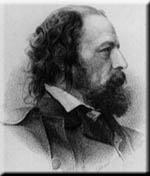
Alfred Lord Tennyson
Born 6th Aug 1809  Died 6th Oct 1892
Died 6th Oct 1892
Alfred Lord Tennyson was fourth child of twelve children born to George and Elizabeth (Fytche) Tennyson. He was born in Somersby, Lincolnshire in England, Tennyson was first educated at home by his father George, a Clergyman, and even as a young man he showed great interest in writing poetry.
In 1827 Tennyson followed in the footsteps of his elder brothers by going to Trinity College. It was here that Tennyson along with one of his brothers became well known after publishing their Poems by two Brothers. Tennyson also won the Chancellors Gold Medal in 1828 for his poem Timbuctoo and later published his own book of poems Chiefly Lyrical in 1830.
While Tennyson was at Trinity College he was invited to join the Apostles, an undergraduate club and met and became close friends with Arthur Henry Hallam. At one time he and Hallam joined the Spanish Revolutionary Army, but Tennyson did not take part in any military action.
In 1931 after his father's death, Tennyson left Cambridge without a degree, but published the first book of his own entitled Poems. Because of the severity of the critics of his work, he never published again until nine years later in 1842, which then gained wide acclaim for his latest works.
Amongst Tennysons most well known Poems are The Lady of Shallot, The Charge of the Lightbrigade and In Memoriam which he wrote as a tribute to his best friend Arthur Hallam after his death.
It was in 1850 that Tennyson married Emily Sellwood, their first child was born dead, in 1851 but later they did have another son. Queen Victoria appointed Tennyson Poet Laureate of England succeeding the poet William Wordsworth.
Acute shortsightedness, made it difficult for Tennyson to read and write, but with encouragement from his close friends he manage to compose and publish a lot of his work. By 1884, Tennyson was made a peer, taking a seat in the House of Lords. He lived a long life dying in Aldsworth Hazelmere in Surrey, at the ripe age of 83. He left us a legacy of his masterpieces which are considered classis and still are read and studied today.